here there 引导的倒装句
倒装句可分为全部倒装和部分倒装

倒装句可分为全部倒装和部分倒装倒装句可分为全部倒装和部分倒装全部倒装是只将句⼦中的谓语动词全部置于主语之前。
此结构通常只⽤与⼀般现在时和⼀般过去时。
常见的结构有:1) here, there, now, then, thus等副词置于句⾸, 谓语动词常⽤be, come, go, lie, run。
There goes the bell.Then came the chairman.Here is your letter.2) 表⽰运动⽅向的副词或地点状语置于句⾸,谓语表⽰运动的动词。
Out rushed a missile from under the bomber.Ahead sat an old woman.注意:上述全部倒装的句型结构的主语必须是名词,如果主语是⼈称代词则不能完全倒装。
Here he comes.Away they went.部分倒装是指将谓语的⼀部分如助动词或情态倒装⾄主语之前。
如果句中的谓语没有助动词或情态动词,则需添加助动词do, does或did,并将其置于主语之前。
1)句⾸为否定或半否定的词语,如no, not, never, seldom, little, hardly, at no time, in no way, not until… 等。
Never have I seen such a performance.Nowhere will you find the answer to this question.Not until the child fell asleep did the mother leave the room.当Not until引出主从复合句,主句倒装,从句不倒装。
注意:如否定词不在句⾸不倒装。
I have never seen such a performance.The mother didn't leave the room until the child fell asleep.典型例题1)Why can't I smoke here?At no time___ in the meeting-roomA. is smoking permittedB.smoking is permittedC. smoking is it permittedD.does smoking permit答案A. 这是⼀个倒装问题。
here there 引导的倒装句知识分享
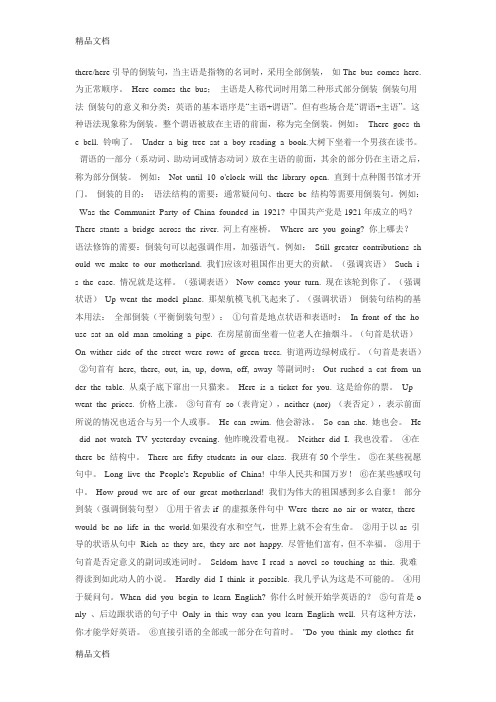
there/here引导的倒装句,当主语是指物的名词时,采用全部倒装,如The bus comes here.为正常顺序。
Here comes the bus;主语是人称代词时用第二种形式部分倒装倒装句用法倒装句的意义和分类:英语的基本语序是“主语+谓语”。
但有些场合是“谓语+主语”。
这种语法现象称为倒装。
整个谓语被放在主语的前面,称为完全倒装。
例如:There goes th e bell. 铃响了。
Under a big tree sat a boy reading a book.大树下坐着一个男孩在读书。
谓语的一部分(系动词、助动词或情态动词)放在主语的前面,其余的部分仍在主语之后,称为部分倒装。
例如:Not until 10 o'clock will the library open. 直到十点种图书馆才开门。
倒装的目的:语法结构的需要:通常疑问句、there be 结构等需要用倒装句。
例如:Was the Communist Party of China founded in 1921? 中国共产党是1921年成立的吗?There stants a bridge across the river. 河上有座桥。
Where are you going? 你上哪去?语法修饰的需要:倒装句可以起强调作用,加强语气。
例如:Still greater contributions sh ould we make to our motherland. 我们应该对祖国作出更大的贡献。
(强调宾语)Such i s the case. 情况就是这样。
(强调表语)Now comes your turn. 现在该轮到你了。
(强调状语)Up went the model plane. 那架航模飞机飞起来了。
(强调状语)倒装句结构的基本用法:全部倒装(平衡倒装句型):①句首是地点状语和表语时:In front of the ho use sat an old man smoking a pipe. 在房屋前面坐着一位老人在抽烟斗。
倒装句强调句讲解
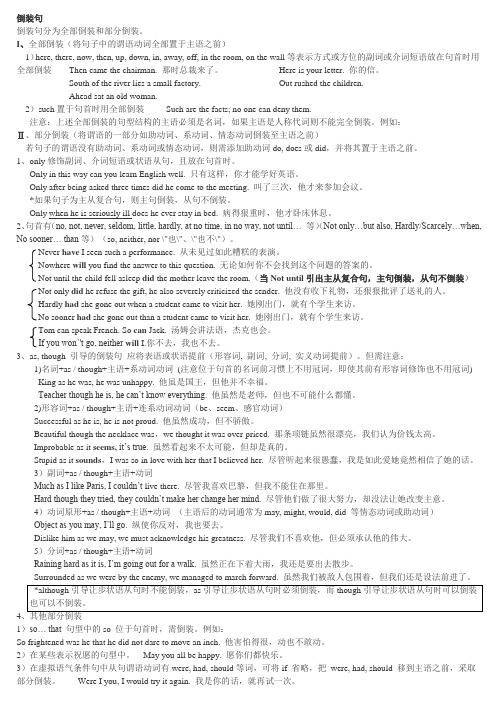
倒装句倒装句分为全部倒装和部分倒装。
I、全部倒装(将句子中的谓语动词全部置于主语之前)1)here, there, now, then, up, down, in, away, off, in the room, on the wall等表示方式或方位的副词或介词短语放在句首时用全部倒装Then came the chairman. 那时总裁来了。
Here is your letter. 你的信。
South of the river lies a small factory. Out rushed the children.Ahead sat an old woman.2)such置于句首时用全部倒装Such are the facts; no one can deny them.注意:上述全部倒装的句型结构的主语必须是名词,如果主语是人称代词则不能完全倒装。
例如:Ⅱ、部分倒装(将谓语的一部分如助动词、系动词、情态动词倒装至主语之前)若句子的谓语没有助动词、系动词或情态动词,则需添加助动词do, does或did,并将其置于主语之前。
1、only修饰副词、介词短语或状语从句,且放在句首时。
Only in this way can you learn English well. 只有这样,你才能学好英语。
Only after being asked three times did he come to the meeting. 叫了三次,他才来参加会议。
*如果句子为主从复合句,则主句倒装,从句不倒装。
Only when he is seriously ill does he ever stay in bed. 病得狠重时,他才卧床休息。
2、句首有(no, not, never, seldom, little, hardly, at no time, in no way, not until… 等)(Not only…but also, Hardly/Scarcely…when, No sooner… than等)(so, neither, nor \"也\"、\"也不\")。
英语倒装句讲解

Inversion
英
语 句
英语句子的自然语序:主语在前,谓语动词在后
子
的 语
英语句子的倒装结构:谓语动词放在主语之前
序
She is a nice girl. 自然语序 Is she a nice girl ? 倒装语序
完全倒装 半倒装
英语倒装句分为两种:
*_完___全__倒__装__: 全部谓语放在主语之前
Little do I dream of seeing such wonderful scenery(风景,景色).
Not until mom came back did she know the truth.
Hardly had he entered the house when it began to rain.
but also we should learn from practice.
❖ 6. 当"so (such)...that..."结构中的 so或such位于句首时,构成部分倒装 句。
❖ So busy is the dentist that he has no time to spare.
7. only位于句首,修饰副词、介词短语 或状语从句时,要用部分倒装。
Up it flew. ( 但 Up flew the plane . )
5、在直接引语全部或部分置于句首时, 引用动词和它的主语(名词)往往要倒装。
“You’ve made great progress this term.” said the teacher.
“Tom”,said his father, “ You shouldn’t make friends with such boys!”
倒装句用法总结

倒装句用法总结专题英语最基本的语序是主语在前,谓语动词在后。
但有时由于句子结构的需要或表示强调,就要采用倒装形式。
倒装分为全部倒装和部分倒装,将谓语动词完全移到主语之前称为完全倒装,只将助动词或情态到主语之前称为部分倒装一、完全倒装(主谓倒装)是指把谓语全部提到主语的前面。
例:In a lecture hall of a university in England sits a professor。
1.以here, there,now, then引导的句子,要完全倒装。
这种句子中的谓语动词通常是不及物动词。
如:Here comes the train!/ There goes the bell!注意:若代词作主语,只把该副词提前主谓语序不变。
Here he comes 。
/ Here it is .2句首以out ,in , up ,away ,down 等副词开头,句子要完全倒装。
(注意,这时句子的主语也必须是名词。
如果是人称代词,也不能使用倒装结构。
)如:Up went the rocket。
/Up it went.3。
介词短语作状语在句首,句子要完全倒装。
注意,这时句子的谓语动词通常是不及物动词。
如:In the front of the lecture hall sat the speaker。
4。
表语置于句首,且主语较长或结构较复杂的句子要用全部倒装。
如:Gone are the days when we ha nothing to eat。
5.so/ neither/ nor 表前面所说的情况也适合于后者,其倒装结构为“so/ neither/ nor+助动词/系动词/情态动词”,这里的主语同前一个句子的主语指的不是同一人或物。
如:She has finished her homework, so has her brother。
She hasn’t gone there,neither/ nor has he.二、部分倒装(助动词倒装)是指把谓语的一部分(助动词)提到主语的前面。
英语倒装句讲解
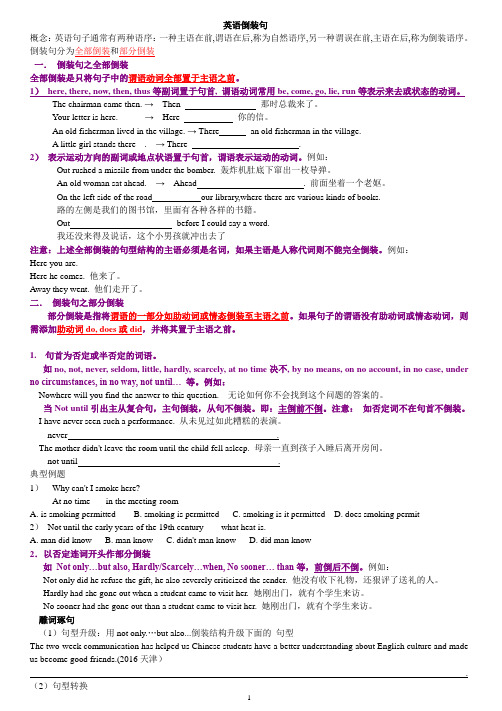
英语倒装句概念:英语句子通常有两种语序:一种主语在前,谓语在后,称为自然语序,另一种谓误在前,主语在后,称为倒装语序。
倒装句分为全部倒装和部分倒装一.倒装句之全部倒装全部倒装是只将句子中的谓语动词全部置于主语之前。
1)here, there, now, then, thus等副词置于句首, 谓语动词常用be, come, go, lie, run等表示来去或状态的动词。
The chairman came then. →Then 那时总裁来了。
Your letter is here. →Here 你的信。
An old fisherman lived in the village. → There an old fisherman in the village.A little girl stands there . → There .2)表示运动方向的副词或地点状语置于句首,谓语表示运动的动词。
例如:Out rushed a missile from under the bomber. 轰炸机肚底下窜出一枚导弹。
An old woman sat ahead. →Ahead . 前面坐着一个老妪。
On the left side of the road our library,where there are various kinds of books.路的左侧是我们的图书馆,里面有各种各样的书籍。
Out before I could say a word.我还没来得及说话,这个小男孩就冲出去了注意:上述全部倒装的句型结构的主语必须是名词,如果主语是人称代词则不能完全倒装。
例如:Here you are.Here he comes. 他来了。
Away they went. 他们走开了。
二.倒装句之部分倒装部分倒装是指将谓语的一部分如助动词或情态倒装至主语之前。
如果句子的谓语没有助动词或情态动词,则需添加助动词do, does或did,并将其置于主语之前。
倒装句讲解

几乎不,仅仅,决不 in
seldom, little, barely 仅够,几乎没有 rarely 不常,很少 nowhere无处,到处都无
at no time 决不 not …until hardly (scarcely)…when, no sooner….than(一…..就)
3、副词now,then,thus(因此,如此) 引导的句子里,谓语 come,follow,begin,end,be等.
Now comes your turn! Then followed another shot of gun. Thus ended the meeting.
4.in,out,down,up,over,away,off,back,below 等副词作状语置于句首时,谓语常用动词有 come,go,rush,等不及物动词。
全部谓语放在主语之前
* 部分倒装: __________
只把助动词,情态动词或连系动词 放在主语之前,谓语的主体部分 仍在主语之后
Can you tell the following ?
There is a table in the room.
完全倒装
Why did you do it like that?
注 意
1)当上述单词不提前时,则不倒装。
I seldom read newspaper before.
He had hardly finished his homework
when the light went out.
2)当这些词作形容词修饰主语时且置句首 时,句子不倒装。 Little work was done yesterday.
倒装用法总结
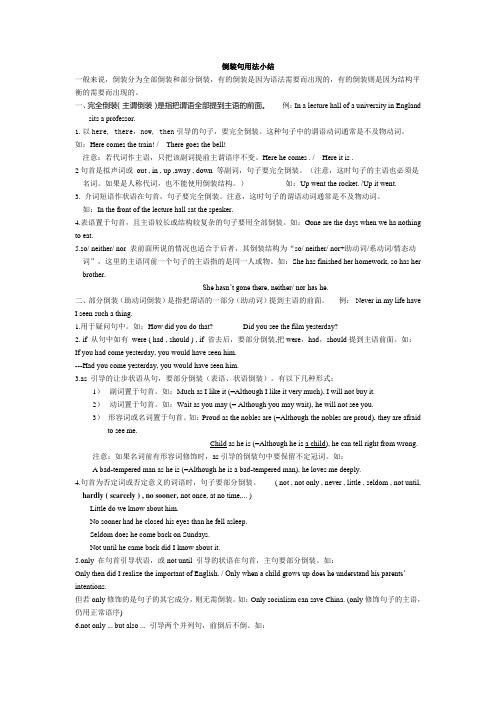
倒装句用法小结一般来说,倒装分为全部倒装和部分倒装,有的倒装是因为语法需要而出现的,有的倒装则是因为结构平衡的需要而出现的。
一、完全倒装(主谓倒装)是指把谓语全部提到主语的前面。
例:In a lecture hall of a university in Englandsits a professor.1.以here, there,now, then引导的句子,要完全倒装。
这种句子中的谓语动词通常是不及物动词。
如:Here comes the train! / There goes the bell!注意:若代词作主语,只把该副词提前主谓语序不变。
Here he comes . / Here it is .2句首是拟声词或out , in , up ,away , down 等副词,句子要完全倒装。
(注意,这时句子的主语也必须是名词。
如果是人称代词,也不能使用倒装结构。
)如:Up went the rocket. /Up it went.3. 介词短语作状语在句首,句子要完全倒装。
注意,这时句子的谓语动词通常是不及物动词。
如:In the front of the lecture hall sat the speaker.4.表语置于句首,且主语较长或结构较复杂的句子要用全部倒装。
如:Gone are the days when we ha nothing to eat.5.so/ neither/ nor 表前面所说的情况也适合于后者,其倒装结构为“so/ neither/ nor+助动词/系动词/情态动词”,这里的主语同前一个句子的主语指的是同一人或物。
如:She has finished her homework, so has her brother.She hasn’t gone there, neither/ nor has he.二、部分倒装(助动词倒装)是指把谓语的一部分(助动词)提到主语的前面。
倒装句讲解

3. Only when your identity has been checked, ________. A. you are allowed in B. you will be allowed in C. will you allow in D. will you be allowed in
全部谓语放在主语之前
* 部分倒装: __________
只把助动词,情态动词或连系动词 放在主语之前,谓语的主体部分 仍在主语之后
Can you tell the following ?
There is a table in the room.
完全倒装
Why did you do it like that?
“You’ve made great progress this term.” said the teacher. “Tom”,said his father, “ You shouldn’t make friends with such boys!”
注意:
1)主语是代词时,倒装不倒装都可以。 “Where are you going?”asked he. (He asked.)
I get up at seven and so does my brother. He didn’t do it and neither did I. He didn’t smoke, nor did he drink.
注意:
1)如果后一个句子只是单纯的重复前面 句子的意思,则不倒装.(…确实是) --It is hot today. --So it is. --He finished it on time. --So he did. 2)如按照别人的意思做了什么事,so也不 用倒装(…某人照办了) The teacher asked me to read louder ,
倒装句
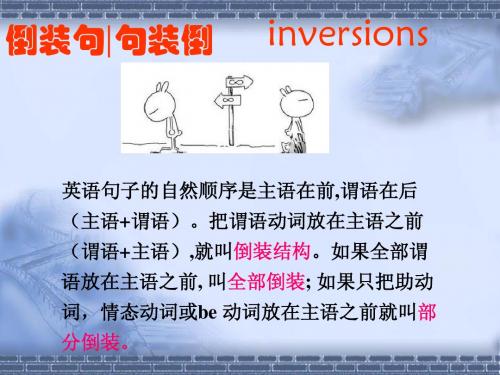
1) There ________. And here ________. A. goes the phone; she comes B. is the phone going; is she C. does the phone go; does she come D. the phone goes; come she 2) Out ________, with a stick in his hand. A. did he rush B. rushed he C. he rushed D. he did rush
2. 当表示地点的介词词组(如on the wall, under the tree, in front of the house, in the middle of the room等)在句首时。 At the foot of the hill lies a beautiful lake. The soldiers ran to the building, on the top of which flew a flag. East of the lake lie two towns. Under the tree was lying a wounded soldier. 3) Near the church ________ cottage. A. was such an old B. had a so old C. was such old a D. is so an old
3. There be结构。另外,在此结构中可以用 来代替be动词的动词有:exist, seem, happen, appear, live, rise, stand等。如: There stood a dog before him. There exist different opinions on this question.
倒装句
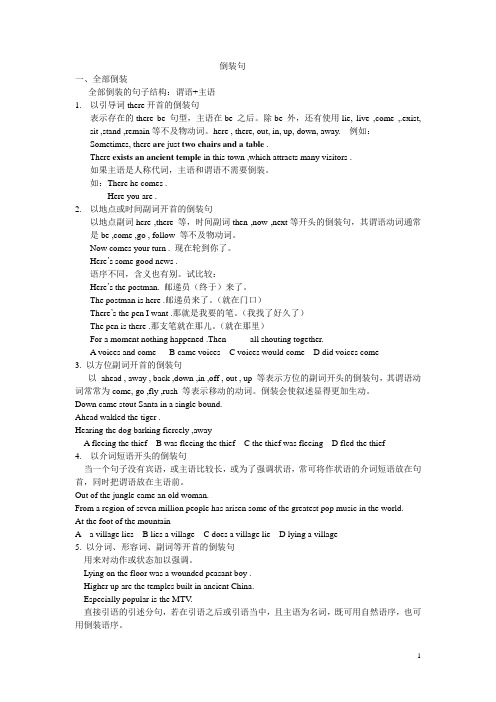
倒装句一、全部倒装全部倒装的句子结构:谓语+主语1.以引导词there开首的倒装句表示存在的there be 句型,主语在be 之后。
除be 外,还有使用lie, live ,come ,.exist, sit ,stand ,remain等不及物动词。
here , there, out, in, up, down, away. 例如:Sometimes, there are just two chairs and a table .There exists an ancient temple in this town ,which attracts many visitors .如果主语是人称代词,主语和谓语不需要倒装。
如:There he comes .Here you are .2.以地点或时间副词开首的倒装句以地点副词here ,there 等,时间副词then ,now ,next等开头的倒装句,其谓语动词通常是be ,come ,go , follow 等不及物动词。
Now comes your turn . 现在轮到你了。
Here’s some good news .语序不同,含义也有别。
试比较:Here’s the postman. 邮递员(终于)来了。
The postman is here .邮递员来了。
(就在门口)There’s the pen I want .那就是我要的笔。
(我找了好久了)The pen is there .那支笔就在那儿。
(就在那里)For a moment nothing happened .Then _____all shouting together.A voices and comeB came voicesC voices would comeD did voices come3. 以方位副词开首的倒装句以ahead , away , back ,down ,in ,off , out , up 等表示方位的副词开头的倒装句,其谓语动词常常为come, go ,fly ,rush 等表示移动的动词。
倒装句的用法
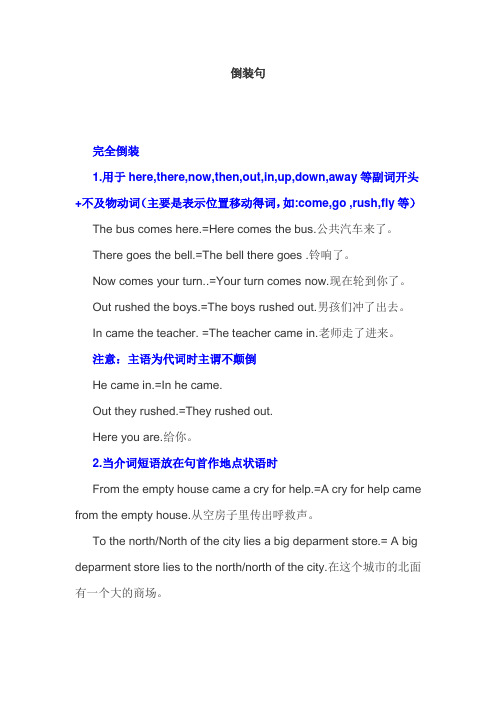
倒装句完全倒装1.用于here,there,now,then,out,in,up,down,away等副词开头+不及物动词(主要是表示位置移动得词,如:come,go ,rush,fly等)The bus comes here.=Here comes the bus.公共汽车来了。
There goes the bell.=The bell there goes .铃响了。
Now comes your turn..=Your turn comes now.现在轮到你了。
Out rushed the boys.=The boys rushed out.男孩们冲了出去。
In came the teacher. =The teacher came in.老师走了进来。
注意:主语为代词时主谓不颠倒He came in.=In he came.Out they rushed.=They rushed out.Here you are.给你。
2.当介词短语放在句首作地点状语时From the empty house came a cry for help.=A cry for help came from the empty house.从空房子里传出呼救声。
To the north/North of the city lies a big deparment store.= A big deparment store lies to the north/north of the city.在这个城市的北面有一个大的商场。
He has never been there.Neither/Nor have I.I like music .So does he.注意:so+主语+谓语意思为的确如此You say he studies hard.So he does and so do you.你说他学习很努力。
他的确很努力你也很努力。
英语倒装句学习:倒装句解析

英语倒装句学习:倒装句解析什么时候倒装以及怎样倒装1、 here,there等地点和方向副词位于句首,用全部倒装,目的是强调状语Here comes a bus.来了一辆公共汽车。
正常语序:A bus comes here.There goes the last train.最后一班火车开走了。
正常语序:The last train goes there.解释一下:倒装主要为了强调,强调的内容放在句首,比如强调here 放到句首,这时就必须用倒装句,把谓语comes 提到主语前面。
像 Here a bus comes. 这种表达是错误的。
这种情况下用全部倒装,就是把所有谓语部分都移动到主语前面,谓语是comes,移动到主语前面,注意这句话的句子成分,bus 是名词,作主语,comes是(不及物)动词,作谓语,这句话没有宾语,here是副词,作状语。
类似还有back, down,off, up, in, out 等表示运动方向的副词:Up went the rocket into the air.火箭升上天空。
正常语序:The rocket went up into the air.Out rushed a young lady.一个年轻女士冲了出来。
正常语序:A young lady rushed out.当我们表达给别人东西或确定人的位置的时候也用倒装(全部倒装),这种倒装常常在 be 动词之后。
Here’s a cup of tea for you.给你一杯茶。
There’s Kate.凯特在那儿。
还有一条例外规则:当主语是代词的时候不用倒装。
He comes here. 他来了。
(正常语序)强调状语here的时候,here提到句首,而主语和谓语位置不发生变化:Here he comes.而不是:Here comes he.Here you are.给你。
而不是:Here are you.2、介词短语充当的地点状语后的倒装:此时依然用全部倒装,谓语动词一般是表示位置的动词如:lie, live, sit, stand 等或转移动词如 come, go, rise 等。
英语倒装句

所修饰的副词、 十、only所修饰的副词、介词短语或状语从句放在 所修饰的副词 句首时,其后面的主语部分要进行倒装, 句首时,其后面的主语部分要进行倒装,如: 1. Only in this way can you hope to improve the situation there. 2. Only then did I realize that I was wrong. 3. Only once did his father discuss his future with him. 4..Only yesterday did I realize what was going on. 5.Only after he came back was I able to see him. only修饰主语 仍用自然语序, 修饰主语, 注:only修饰主语,仍用自然语序,如: Only socialism can save China.
3.Should anyone call, tell him to wait for me here.
4.Were I ten years younger, I would be able to climb to the top of the hill. 5.Should you change your mind, let us know. (If I were you …不倒装)
十一、 含有否定意义的副词、 十一 、 含有否定意义的副词 、 连词或短语构成的 状语放在句首时,常用倒装语序。 状语放在句首时,常用倒装语序。 这些词和词组有: 这些词和词组有 : not, never, hardly, seldom, little, rarely, scarcely, not until, not only…but also…, neither…nor…, no sooner…than…, hardly…when …, scarcely…when等,例如: 等 例如: 1. Never shall I forget the day when I joined the League. 2. Not until I began to work did I realize how much time I had wasted.
- 1、下载文档前请自行甄别文档内容的完整性,平台不提供额外的编辑、内容补充、找答案等附加服务。
- 2、"仅部分预览"的文档,不可在线预览部分如存在完整性等问题,可反馈申请退款(可完整预览的文档不适用该条件!)。
- 3、如文档侵犯您的权益,请联系客服反馈,我们会尽快为您处理(人工客服工作时间:9:00-18:30)。
there/here引导的倒装句,当主语是指物的名词时,采用全部倒装,如The bus comeshere.为正常顺序。
Here comes the bus; 主语是人称代词时用第二种形式部分倒装倒装句用法倒装句的意义和分类:英语的基本语序是“主语+谓语”。
但有些场合是“谓语+主语”。
这种语法现象称为倒装。
整个谓语被放在主语的前面,称为完全倒装。
例如: Th ere goesthe bell. 铃响了。
Under a big tree sat a boy reading a book.大树下坐着一个男孩在读书。
谓语的一部分(系动词、助动词或情态动词)放在主语的前面,其余的部分仍在主语之后,称为部分倒装。
例如: Not until10 o'clockwill the libraryopen.直到十点种图书馆才开门。
倒装的目的: 语法结构的需要:通常疑问句、there be 结构等需要用倒装句。
例如: Was the Communist Partyof China founded in 1921?中国共产党是1921年成立的吗? Therestants a bridge acrossthe river. 河上有座桥。
Where are you goin g? 你上哪去?语法修饰的需要:倒装句可以起强调作用,加强语气。
例如: Still gr eater contributions shouldwemake to our motherland. 我们应该对祖国作出更大的贡献。
(强调宾语)Such is thecase. 情况就是这样。
(强调表语)Now comes your turn. 现在该轮到你了。
(强调状语)Up went the m odel plane. 那架航模飞机飞起来了。
(强调状语) 倒装句结构的基本用法:全部倒装(平衡倒装句型):①句首是地点状语和表语时: In frontof the house sat an old m an smoking apipe.在房屋前面坐着一位老人在抽烟斗。
(句首是状语) Onwitherside of the street were rows ofgreen trees. 街道两边绿树成行。
(句首是表语)②句首有 here, there, out, in, up, down, off, away 等副词时: Out rushed a cat from under the table.从桌子底下窜出一只猫来。
Here is a ticket for you.这是给你的票。
Up went the prices. 价格上涨。
③句首有so(表肯定),neither (nor) (表否定),表示前面所说的情况也适合与另一个人或事。
He canswim. 他会游泳。
So can she.她也会。
He did not w atch TV yesterday evening. 他昨晚没看电视。
Neither didI. 我也没看。
④在there be结构中。
There are fifty students in our class.我班有50个学生。
⑤在某些祝愿句中。
Long live the People's Republicof China!中华人民共和国万岁! ⑥在某些感叹句中。
How proud we are of o ur great motherland!我们为伟大的祖国感到多么自豪! 部分到装(强调倒装句型)①用于省去if 的虚拟条件句中 Were there no air or water, there would beno life in the world.如果没有水和空气,世界上就不会有生命。
②用于以as 引导的状语从句中 Rich as they are, they are not happy. 尽管他们富有,但不幸福。
③用于句首是否定意义的副词或连词时。
Seldom have I read a novel so touching as this. 我难得读到如此动人的小说。
Hardly did I think it possible. 我几乎认为这是不可能的。
④用于疑问句。
When did you b egin to learn English? 你什么时候开始学英语的?⑤句首是only、后边跟状语的句子中 Only inthis way can you learn English well. 只有这种方法,你才能学好英语。
⑥直接引语的全部或一部分在句首时。
"Do you think my clothes fit well?" asked the emperor.“你认为我的衣服非常合身吗?”皇帝问道。
"Mrsmith" saidmary,"MayI borrow your pen?" “史密斯先生”玛丽说,“我可以借一下你的钢笔吗?” ⑦某些祝愿的句子(谓语带有情态动词,则为部分倒装)。
May you succeed. 祝您成功。
重难点分析 1.由疑问词或有疑问词修饰的名词作主语的特殊疑问句不倒装。
如: Who isyourmathsteacher? 谁是你的数学老师?(who 是主语) Which bicycle is yours? 哪辆自行车是你的?(which是定语,修饰bi cycle ) 2.在以here, there, now,then…等开头的句子中here, there强调地点但不指具体的地点,只用来引起人们的注意,要重读。
同样 now, then 强调时间,也并不指具体时间,只引起人们的注意,也要重读。
如: There comesour teacher.我们的老师来了。
在时态方面要注意,除了以then 开头的句子用过去时外,其余均用一般现在时。
如: Then came a new problem.那时出现了新问题。
3.主语是人称代词时不倒装。
如: Herewe are. 我们到了。
(Here are we错)Away he went.他走开了。
(Away wenthe.错)There he comes.他来了。
(There comeshe. 错) 4.为了使句子生动、流畅,常把 in, out, down, up,away, off 等,副词放在句首,采用全部倒装语序,不加助动词( do, does等)句子的动词一般都是不及物的行为动词。
如:In came the manager. 经理来了。
不说:In didthe ma nagercome. 当主语是人称代词时,一般只把副词放在句首,不倒装。
例如: In he c ame and the lesson began.他进来了,于是开始上课。
不说:In came he and lesson began. 5.only 放在句首,但修饰的不是状语而是主语时,不倒装。
如: Only J ohn is allowed to enterthelab. 只有约翰被允许进入实验室。
Only the boy himself knows what he is going to be.只有这孩子本人知道他将来的前途。
6.以so 开头的句子。
如果只是重复前面一句话的意思,不倒装。
如: It wa s very cold yesterday.昨天很冷。
So it was.正是这样。
He did a goodjob. 他干的很出色。
So he did. 确实如此。
7.以 notonly开头的句子要倒装,但but also后面的句子不倒装。
如: Not only did he speak more correctly, but also he spoke more easily. 不仅他说得更准确,而且他说得也更轻松。
8.以not until开头的句子主句要倒装,没有助动词时要加助动词。
如:Not until Mother came back didit stop raining.直到妈妈回来雨才停。
9.带有否定意义的副词和状语词组放在句首时,句子要倒装,这样的副词常见的有:no sooner…than, hardly…when, not until, never, hardly, seldom, scarecely, little, barely, at no time(=never) 等。
在使用时要特别注意以hardly(barely/scarcely)…when 和no sooner…than开头的句子。
在这种倒装句中,主句倒装从句不倒装。
如: Hardly had he gotinto the room when the telephone rang.他一进屋,电话就响了。
10.频度状语如 often, seldom 等,地点状语如in fro nt of, in themiddle of等,位于句首时,句子要倒装,没有助动词时要加助动词。
如: Seldom does it snowhere.这里很少下雪。
11.充当表语的单数名词放在句首时,不加任何冠词,也不用复数形式。
如: Childas he is, heknows a lot .虽然他是个孩子,可知道的事挺多。
12.为了强调某一动作或使句子平稳和谐,将表语(形容词、现在分词、过去分词)放在句首并倒装。
如: Lateas itwas, he st illcontinuedlearning in a poorlight.虽然天色已晚,他仍继续在微弱的光线下学习。
Late as itwas表示让步,是as 的一种用法,意思相当于Though it was late 。
再举一例:Written on the box isthe mo del of the machine. 箱子上写了机器的型号。
这个句子的正常语序是:The model of the machineiswritten on the box. written 是过去分词在句中作表语。
注意本句不是被动语态,而是系表结构。
